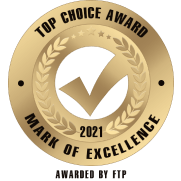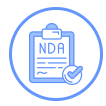Best Practices for Writing Clean and Maintainable Code in Software Development
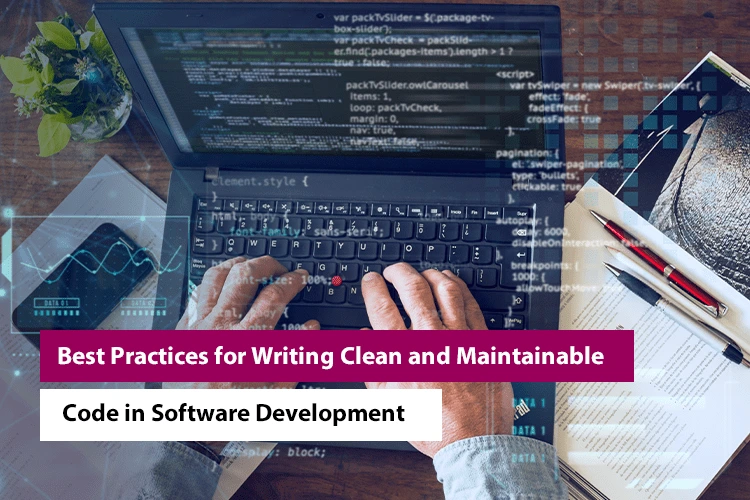
Did you know that bad code costs companies billions of dollars every year in maintenance and debugging? According to a report, developers spend up to 50% of their time on debugging issues arising from messy and unclear code. That is the time spent that could be used in developing new features or performance improvement. Clean code is not just aesthetics; it’s part of how successful software development goes.
In today’s fast-changing world of technology, software has to be agile and adaptive in meeting business needs. Whether it is adding new features, troubleshooting bugs, or onboarding a new developer, clean and maintainable code is the foundation for success. It’s like building a house on solid ground; without it, the entire structure becomes unstable over time.
At Imenso Software, we’ve seen how adherence to software development best practices transforms not just codebases but entire projects. What we’ve learned from our expertise in custom software development services and dedicated development teams is that clean, maintainable code is the key to delivering outstanding results. In this blog, we’ll guide you through the top practices that will help you achieve easy-to-read, modify, and scale code.
Why Is Clean and Maintainable Code Important?
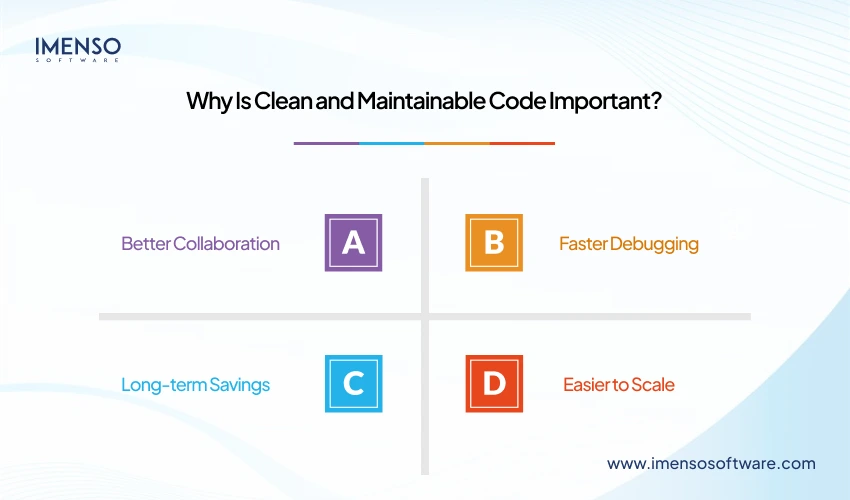
Clean and maintainable code will make sure that the software system stays functional and adaptable over time. Let’s break down its benefits.
Better Collaboration: Clean code is easier to understand so that members can collaborate more easily in a team. This matters especially when dedicated development teams work on projects that have been developed, ensuring that onboard times and miscommunication get reduced.
Faster Debugging: Messy code makes it harder to debug. Clean code helps developers spot issues quickly and fix them, which reduces the chances of production delays.
Long-term Savings: While writing clean code takes a little more time upfront, it reduces the cost of maintenance and technical debt in the long run for developers and clients alike.
Easier to Scale: Clean code facilitates the addition of new features and increases the scale of the application. This is important for custom software development services adapting to business growth.
Best Practices for Writing Clean and Maintainable Code4
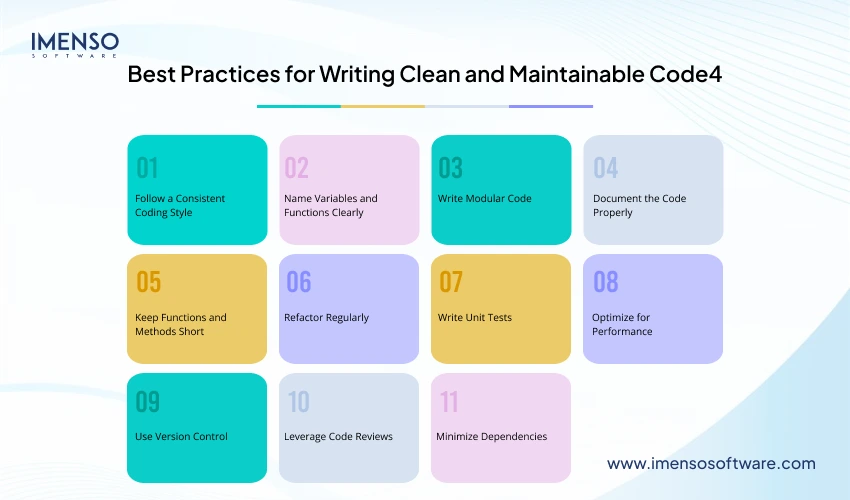
The best practices in clean code ensure that long-term success and efficiency in software development will be attained. Such practices help developers write code that is easy to understand, modify, and scale with the project size.
Follow a Consistent Coding Style
Uniform coding style across the project is one of the most basic yet important practices. This uniformity will allow dedicated development teams to easily comprehend and contribute to the project.
How to Achieve This:
- Automatic style checks with tools such as ESLint or Prettier.
- Document and share the coding style guide with the team.
- Code reviews are incorporated as part of the development process.
At Imenso Software, our developers adhere to strict style guidelines to ensure every project is easy to maintain and extend.
Imenso Software insists on regular style guides of our developers to ensure that every project is maintainable and extendable.
Name Variables and Functions Clearly
The most horrible nightmare for any developer is having ambiguous or cryptic names. Instead, use descriptive names to indicate what variables and functions are about. That makes the code self-explanatory and reduces the necessity for excessive comments.
Examples:
- Replace temp with the temporary file.
- Replace calc with calculate total revenue.
Meaningful names are always helpful in effective web application development, as this helps in smooth handovers and updates.
Write Modular Code
Breaking down the code into smaller, reusable modules is the need of the day to keep the architecture clean and maintainable. Modules help to isolate functionalities, making it easier to debug and update without affecting other parts of the application.
Steps to Modularize Code:
- Identify reusable functionalities.
- Create independent modules or classes for each functionality.
- Use a standard module structure to improve readability.
The incorporation of modularity into our custom software development service will make even the most complex projects manageable and scalable.
Document the Code Properly
The neatest of code always deserves solid documentation. Though it must itself be well-explanatory at times, additional details about its use, what kind of inputs are expected, and its likely outputs help save hours from debugging and onboarding processes.
Documentation Best Practices:
- Use inline comments for tricky logic.
- Maintain separate API documentation.
- Use tools like Swagger for documenting endpoints.
Documentation will be a major aspect of software maintenance and support services by ensuring smooth transits for long-term usage.
Keep Functions and Methods Short
Longer functions are more difficult to understand and debug. In general, a function should do one thing. If it does anything more, break it into a smaller function.
Benefits of Short Functions:
- Improved readability.
- Easier testing and debugging.
- Better reusability in multiple parts of the application.
By following this, our hardworking development teams can communicate and come up with brilliant ideas without getting tangled in cluttered code.
Refactor Regularly
Refactoring is the process of cleaning up existing code without changing its behavior. It helps eliminate redundancy, optimize performance, and improve readability.
Key Refactoring Tips:
- Identify and eliminate duplicate code.
- Simplify complex logic.
- Use tools like SonarQube to detect code smells.
Regular refactoring is part of the software development best practices and keeps your project maintainable even when it grows.
Write Unit Tests
Unit tests make sure that your code behaves as you expect it to and avoid bugs in future changes.
How to Incorporate Testing:
- Write test cases for all critical components.
- Use frameworks like JUnit, Mocha, or Jest for automation.
- Integrate testing into your CI/CD pipeline.
At Imenso Software, we have testing as part of our development cycle, particularly when providing custom software development services.
Optimize for Performance
Clean code isn’t just about readability; it should also be efficient. Optimize loops, avoid redundant database calls, and use caching where possible.
Tips for Performance Optimization:
- Profile your code to identify bottlenecks.
- Use algorithms and data structures suitable for your use case.
- Minimize dependencies to reduce bloat.
This focus on performance is part of our best web application development practices, ensuring applications deliver an excellent user experience.
Use Version Control
With Version control systems like Git, it’s possible to track changes, collaborate with others, and revert in case something goes wrong.
Best Practices for Version Control:
- Commit code frequently with meaningful messages.
- Use branches to isolate development work.
- Perform regular code reviews.
Our dedicated development teams use Git Workflows to make sure everything that’s going on remains transparent and organized with all projects.
Leverage Code Reviews
Code reviews serve an essential purpose that never ceases to be significant as they assist in bug hunting, upgrade the code quality, and help share knowledge across the group.
How to Conduct Effective Code Reviews:
- Focus on readability and logic rather than nitpicking.
- Use tools like GitHub or Bitbucket for collaboration.
- Encourage a culture of constructive feedback.
This collaborative approach is the backbone of our software maintenance and support services, where all lines of code work toward project objectives.
Minimize Dependencies
Relying on too many external libraries or frameworks complicates updates and increases the vulnerability to risks.
Strategies to Manage Dependencies:
- Choose well-maintained libraries with active support.
- Regularly update dependencies to their latest stable versions.
- Avoid unnecessary dependencies by writing custom solutions when feasible.
This is in line with our custom software development services, where we balance flexibility and stability for long-term success.
Tools and Techniques for Writing Clean Code
With a bit of know-how and the right tools, creating clear and compact code and making necessary updates is not much of a bother. It not only helps ensure consistency but also catches errors before they become big problems. Let’s break it down:
Use Linters and Formatters
- Linters catch issues like syntax errors or unused variables.
- Formatters ensure consistent code structure and style.
- They make code easier to read and reduce errors.
Leverage Design Patterns
- Use patterns like Singleton or Factory to solve common problems.
- They make your code reusable and easier to maintain.
- Patterns provide a clear framework for writing better code.
Adopt Version Control Systems
- Tools like Git track changes in your code.
- You can revert to older versions when needed.
- Version control helps teams collaborate efficiently.
Use Code Review Tools
- Tools like GitHub let team members review each other’s code.
- Reviews catch mistakes and ensure quality.
- They help enforce consistent coding standards.
Automate Testing
- Testing tools like Selenium check for bugs automatically.
- They ensure code updates don’t break functionality.
- Automated tests save time and improve code reliability.
Utilize IDE Features
- IDEs like Visual Studio highlight errors in real-time.
- They offer tools like debugging and auto-completion.
- IDEs speed up coding and make it more accurate.
Challenges in Writing Clean Code and How to Overcome Them
No matter how much one desires, writing clean code may not be an easy affair. Here are some of the common challenges and ways to overcome them
Time Constraints and Tight Deadlines
- Challenge: Time pressure for meeting deadlines leads to cutting corners in the code.
- Solution: Maintain quality right from the beginning. Schedule the refactoring time and keep improving your code regularly. This will ensure there are no large-scale repairs required later.
Team Inconsistencies in Coding Styles
- Challenge: Team members may have different coding styles, which makes the code difficult to read and understand.
- Solution: Define a clear coding standard that everyone has to follow. Use tools like linters to automatically check that everyone sticks to the rules.
Dealing with Legacy Code
- Challenge: Working with old, messy code can be overwhelming and hard to change.
- Solution: Begin to tangle with legacy code a small piece at a time. Gradually refactor and improve sections of the code, testing everything before making changes.
These are challenges that will underscore why software development best practices are essential for long-term success.
Final Reflections
Clean and maintainable code forms the basis of any successful software development. They ensure systems that are easy to update, scalable, and most importantly cost-effective in the long run. Challenges include tight deadlines, and legacy code, but practices and mindset correct them.
Imenso Software values, within every project, strong quality code combined with high value in custom software development services and dedicated development teams towards delivering solutions that can indeed endure the test of time, providing cleaner code and smoother process flows for all clients in committing themselves to best practices concerning the development of software.
Starting a new project or managing an existing one requires investment in clean code now to save time, money, and headaches tomorrow. Together, let’s build smarter and better software. Contact us to explore how our expertise can help transform your ideas into success.
Want more information about our services?
Similar Posts

Are You Looking To Hire React Native Developers To Build Mobile Apps?
When Facebook was looking for a technology to make the app more robust and fast without any downtime, that is when React Native was developed. And since its launch, it has been the talk of the app town. Facebook trusts its technology and so far has used React native to build Instagram and Facebook ads. ...

Top 10 Front-End Frameworks for Modern Web Development
In today’s digital landscape, front-end development stands at the forefront of innovation, enabling the creation of dynamic, responsive, and visually stunning web applications. With an array of front-end frameworks available, software developers have a wealth of options to choose from when embarking on modern web development projects. These frameworks not only streamline the development process […]...
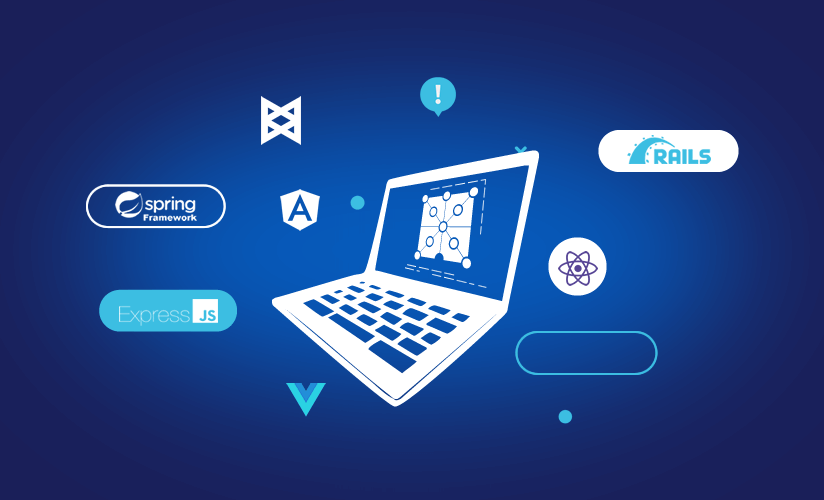
Best Web Development Frameworks In 2019
Frameworks have proven to be an indispensable part of the web development mix. As web application standards continue to rise, so does the complexity of the tech needed. However, it makes no sense to reinvent the wheel for such multifaceted technologies – that is if you can reinvent any of it. That is why using […]...







